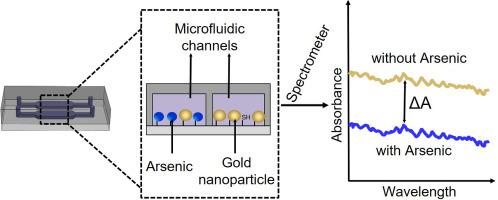Microelectronic Engineering ( IF 2.3 ) Pub Date : 2021-06-12 , DOI: 10.1016/j.mee.2021.111583 Betul Karakuzu , Yekta Gulmez , H. Cumhur Tekin

|
Rapid and portable analysis of arsenic (As) contamination in drinking water is very important due to its adverse health effects on humans. Available commercial detection kits have shown low sensitivity and selectivity in analysis, and also they can generate harmful by-products. Microfluidic-based approaches allow portable analysis with gold nanoparticles (AuNPs) as labels. However, they need complex surface modification steps that complicate detection protocols. Due to the lack of precise sensing and affordable solution, we focused on developing a microfluidic platform that uses a push-and-pull pumping method for sensitive detection of As. In this detection principle, a sample is introduced in the microfluidic channel modified with -SH functional groups where As can bind. Then, AuNPs are given in the channel and AuNPs bind on free -SH functional groups which are not allocated with As. Absorbance measurements are conducted to detect AuNPs absorbed on the surfaces and the resulting absorbance value is inversely proportional with As concentration. The method enables detection of As down to 2.2 μg/L concentration levels in drinking water, which is well-below the allowed maximum As concentration of 10 μg/L in the drinking waters by the World Health Organization (WHO). The paper reveals that multiple push-and-pull pumping of fixed volume of sample and AuNPs with a syringe pump can improve the binding efficiency in the microfluidic channel. With this technique, low amounts of sample (1 mL) and short total assay time (25 min) are sufficient to detect As.
中文翻译:

基于吸光度的推拉泵微流体系统中砷的检测
饮用水中砷 (As) 污染的快速便携式分析非常重要,因为它对人类健康有不利影响。现有的商业检测试剂盒在分析中表现出低灵敏度和选择性,并且它们会产生有害的副产物。基于微流体的方法允许使用金纳米粒子 (AuNP) 作为标签进行便携式分析。然而,它们需要复杂的表面改性步骤,这使检测协议复杂化。由于缺乏精确的传感和负担得起的解决方案,我们专注于开发一种微流体平台,该平台使用推拉泵浦方法对 As 进行灵敏检测。在该检测原理中,样品被引入到微流体通道中,该通道修饰了 As 可以结合的 -SH 官能团。然后,AuNPs 在通道中给出,AuNPs 结合在没有分配 As 的游离 -SH 官能团上。进行吸光度测量以检测吸附在表面上的 AuNP,所得的吸光度值与 As 浓度成反比。该方法能够检测到饮用水中低至 2.2 μg/L 的砷浓度水平,远低于世界卫生组织 (WHO) 允许的饮用水中 10 μg/L 的最大砷浓度。该论文揭示了使用注射泵对固定体积的样品和 AuNP 进行多次推拉泵送可以提高微流体通道中的结合效率。使用这种技术,少量样品 (1 mL) 和较短的总分析时间 (25 分钟) 就足以检测 As。进行吸光度测量以检测吸附在表面上的 AuNP,所得的吸光度值与 As 浓度成反比。该方法能够检测到饮用水中低至 2.2 μg/L 的砷浓度水平,远低于世界卫生组织 (WHO) 允许的饮用水中 10 μg/L 的最大砷浓度。该论文揭示了使用注射泵对固定体积的样品和 AuNP 进行多次推拉泵送可以提高微流体通道中的结合效率。使用这种技术,少量样品 (1 mL) 和较短的总分析时间 (25 分钟) 就足以检测 As。进行吸光度测量以检测吸附在表面上的 AuNP,所得的吸光度值与 As 浓度成反比。该方法能够检测到饮用水中低至 2.2 μg/L 的砷浓度水平,远低于世界卫生组织 (WHO) 允许的饮用水中 10 μg/L 的最大砷浓度。该论文揭示了使用注射泵对固定体积的样品和 AuNP 进行多次推拉泵送可以提高微流体通道中的结合效率。使用这种技术,少量样品 (1 mL) 和较短的总分析时间 (25 分钟) 就足以检测 As。饮用水中 2 μg/L 的浓度水平,远低于世界卫生组织 (WHO) 允许的饮用水中 10 μg/L 的最大砷浓度。该论文揭示了使用注射泵对固定体积的样品和 AuNP 进行多次推拉泵送可以提高微流体通道中的结合效率。使用这种技术,少量样品 (1 mL) 和较短的总分析时间 (25 分钟) 就足以检测 As。饮用水中 2 μg/L 的浓度水平,远低于世界卫生组织 (WHO) 允许的饮用水中 10 μg/L 的最大砷浓度。该论文揭示了使用注射泵对固定体积的样品和 AuNP 进行多次推拉泵送可以提高微流体通道中的结合效率。使用这种技术,少量样品 (1 mL) 和较短的总分析时间 (25 分钟) 就足以检测 As。


























 京公网安备 11010802027423号
京公网安备 11010802027423号